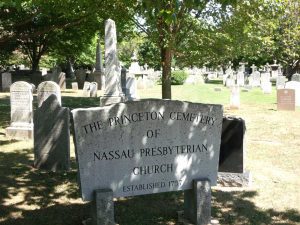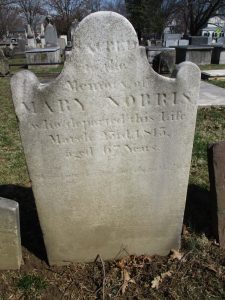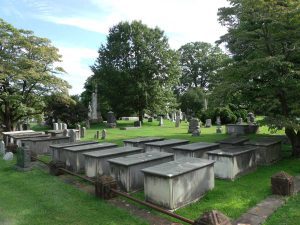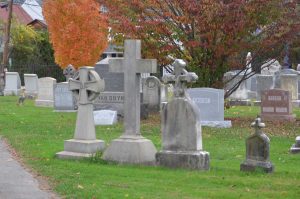
The Princeton Cemetery was established in 1757 and is the final resting place of many notable Princeton residents. Visitors regularly come in search of Aaron Burr, John Witherspoon and Grover Cleveland. But the cemetery and its residents have so much more to tell about the history of our community. A stroll through the cemetery reveals the impact of the university, the seminary and the Institute for Advanced Study with scholars, theologians, scientists and more. That same stroll opens the door to the history of a vibrant African American community, a large Italian American community, a community rich in religious and cultural diversity.
The cemetery is owned by Nassau Presbyterian Church. Over a decade ago the church embarked on a project to assure that records of the cemetery were properly preserved, and all interments recorded as accurately as possible. This project has recently been completed. Along the way we have learned about some of the residents whose names are less familiar but whose stories are no less compelling than those of some of our more notable residents.
Here are some examples of interesting stories we have discovered:
 Mary Norris (~1746-1815). We learned about Mary Norris when the Museum of the American Revolution was working on a project for the centennial of women’s suffrage. The Museum discovered Mary’s name on a voting poll list from October 13, 1801. She resided on what is now Nassau Street as a widow after her husband died in 1789 without a will. She served as the administrator of his estate and inherited his property which included a 10-acre plot of land. As a property owner, she was able to vote. In 1807, New Jersey restricted voting to propertied white men. It would be over 110 years before women regained the right to vote.
Mary Norris (~1746-1815). We learned about Mary Norris when the Museum of the American Revolution was working on a project for the centennial of women’s suffrage. The Museum discovered Mary’s name on a voting poll list from October 13, 1801. She resided on what is now Nassau Street as a widow after her husband died in 1789 without a will. She served as the administrator of his estate and inherited his property which included a 10-acre plot of land. As a property owner, she was able to vote. In 1807, New Jersey restricted voting to propertied white men. It would be over 110 years before women regained the right to vote.
Guy Chew (1804-1826) was the first Native American known to have been buried in the Cemetery. He was a Mohawk who became a Christian when he was eighteen, studied for three years at a mission school, and died while preparing for missionary work at Princeton Theological Seminary.
William Milligan Sloane (1850-1928) was a professor of Latin and history at Princeton University and later a professor of history at Columbia University. When the International Olympic Committee was founded in 1894, Sloane was one of two constituent American members of the committee. In that role, he was a founder and president of the American Olympic committee (now the US Olympic Committee). He escorted the first American team to the modern Olympic Games in Athens in 1896.
Christine Moore Howell (1899-1972) was the first African American graduate of Princeton High School. She went on to study chemistry in Paris and became one of Princeton’s most accomplished entrepreneurs of the 1930s. She founded her own line of cosmetics and served as the head of the NJ Board of Beauty Culture Control after being appointed to the board by the governor. She operated Christine Vanity Parlors on Spring Street in property owned by her father, William Moore.
Donald Lambert (1904-1962) was a jazz pianist best known for playing in Harlem nightclubs in the 1920s. He was taught to play the piano by his mother but never learned to read music – instead playing by ear or improvisation. He was known for a rapid left hand striding technique. This skill made him a great success at a form of musical competition known as cutting contests. This involved piano players taking turns trying to make a simple melody faster, more complicated and exciting. Lambert became well knows in the jazz community and was known as “the Lamb”, “Jersey Rocket”, “Muffin” and “The Lamb of God.” A few recordings of his music still exist. His monument in Princeton cemetery is adorned with musical notes.

These are just a few of the many interesting residents of the Princeton Cemetery. In addition to a US President, US Vice-President, NJ Governor, Nobel and Pulitzer Prize winners, the cemetery is the final resting place of generations of soldiers, professors, politicians, musicians, scientists, business executives, and writers, as well as those who have called the Princeton area home and contributed to the community in diverse ways.
The cemetery is open to visitors every day during daylight hours so feel free to visit and explore. You may enter at 29 Greenview Ave. In addition to the interesting stories of residents, the cemetery has a collection of many styles of stones and memorials – false crypts, tabletops, obelisks, etc. The children might enjoy looking for the stone that says “I told you I was sick” or the etching of the Milky Way or the bench with a dragon and a unicorn.
 Our website includes information on residents of note. As part of the culmination of our records project, we have also recently added an interactive map where you can locate not only these notable residents but also anyone interred in the cemetery. This will be an invaluable resource to the many people who call and visit looking for members of their own families. This resource can be found here.
Our website includes information on residents of note. As part of the culmination of our records project, we have also recently added an interactive map where you can locate not only these notable residents but also anyone interred in the cemetery. This will be an invaluable resource to the many people who call and visit looking for members of their own families. This resource can be found here.
